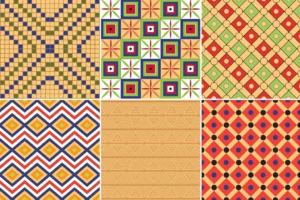
Egyptian Patterns: 5 Captivating Insights
Egyptian patterns are a captivating aspect of ancient Egyptian art, reflecting the culture’s deep connection to nature, spirituality, and daily life. These intricate designs, found in everything from architecture to textiles, offer a glimpse into the values and beliefs of one of history’s most fascinating civilizations. In this blog post, we’ll explore the significance of Egyptian patterns, their various forms, and their lasting impact on art and design.
The Significance of Egyptian Patterns
Cultural and Religious Importance
Egyptian patterns were not merely decorative; they held profound cultural and religious significance. These designs were often imbued with symbolic meanings, representing concepts such as life, death, protection, and power. Patterns were used to adorn temples, tombs, and everyday objects, serving as a constant reminder of the divine and the eternal.
Connection to Nature
The ancient Egyptians had a deep reverence for nature, which is reflected in their patterns. Many designs incorporate elements from the natural world, such as plants, animals, and celestial bodies. This connection to nature was not only aesthetic but also symbolic, representing the harmony and balance that the Egyptians sought in their lives.
Common Egyptian Patterns
Geometric Patterns
Geometric patterns were prevalent in Egyptian art, characterized by their precision and symmetry. These designs often included:
Chevron and Zigzag: Representing water or the Nile, these patterns were commonly used in jewelry and pottery.
Grid and Checkerboard: Symbolizing order and structure, these patterns were often found in architectural elements and textiles.
Floral and Fauna Patterns
Nature-inspired patterns were a staple of Egyptian design, reflecting the importance of the natural world in their culture.
Lotus and Papyrus: The lotus flower symbolized creation and rebirth, while the papyrus plant represented the Nile and fertility. These motifs were frequently used in temple decorations and jewelry.
Animal Motifs: Animals like the scarab beetle, falcon, and cobra were common in Egyptian patterns, each carrying its own symbolic meaning. The scarab, for example, represented transformation and protection.
Symbolic Patterns
Many Egyptian patterns were rich in symbolism, often used to convey religious or protective meanings.
Ankh: The ankh symbol, representing life and immortality, was a common motif in Egyptian patterns, often incorporated into jewelry and amulets.
Eye of Horus: This symbol of protection and healing was frequently used in patterns on amulets, pottery, and wall carvings.
Techniques and Materials
Artistic Techniques
The creation of Egyptian patterns involved a variety of techniques, each requiring skill and precision.
Carving and Engraving: Patterns were often carved into stone or wood, particularly in temples and tombs. This technique allowed for intricate designs that could withstand the test of time.
Painting: Many patterns were painted onto surfaces, using natural pigments to create vibrant colors. This was common in tombs and on pottery.
Weaving and Embroidery: Textiles often featured complex patterns, created through weaving or embroidery. These techniques were used to produce clothing, tapestries, and decorative items.
Materials Used
The materials used in creating Egyptian patterns were chosen for their availability and symbolic significance.
Stone: Limestone, sandstone, and granite were commonly used for carving patterns in architecture and sculpture.
Papyrus and Linen: These materials were used for writing and textiles, often featuring painted or woven patterns.
Gold and Faience: Precious materials like gold and faience were used in jewelry and decorative items, highlighting the importance of the patterns they bore.
The Legacy of Egyptian Patterns
Influence on Art and Design
Egyptian patterns have had a lasting impact on art and design throughout history. Their emphasis on symmetry, symbolism, and nature has inspired artists and designers across cultures and eras. The Art Deco movement, for example, drew heavily on Egyptian motifs, incorporating geometric patterns and stylized forms into architecture and fashion.
Preservation and Discovery
The preservation and discovery of Egyptian patterns have provided invaluable insights into ancient Egyptian culture and history. Archaeological excavations continue to uncover artifacts adorned with these patterns, offering new perspectives on the lives and beliefs of the ancient Egyptians. Museums around the world, such as the Egyptian Museum in Cairo and the Louvre in Paris, house extensive collections of items featuring these patterns, allowing people to connect with this ancient civili
zation.
Modern Interpretations
Today, Egyptian patterns continue to inspire artists, designers, and architects. Their timeless appeal and rich symbolism are often reimagined in contemporary art, fashion, and interior design. From jewelry collections to home decor, the influence of Egyptian patterns is evident in many aspects of modern life.
Experiencing Egyptian Patterns Today
Museums and Exhibits
To truly appreciate the beauty and intricacy of Egyptian patterns, visiting museums with Egyptian collections is invaluable. Institutions like the British Museum and the Metropolitan Museum of Art offer extensive displays of artifacts featuring these patterns, providing a deeper understanding of their significance.
DIY Egyptian-Inspired Projects
For those interested in incorporating Egyptian patterns into their own creations, consider:
Home Decor: Use stencils or decals to add Egyptian-inspired patterns to walls, furniture, or textiles.
Jewelry Making: Create your own jewelry using beads and charms that feature traditional Egyptian motifs.
Art Projects: Experiment with painting or drawing Egyptian patterns, exploring their symmetry and symbolism.
Conclusion
Egyptian patterns are more than just decorative elements; they are a testament to a civilization that valued art, nature, and spirituality. From the intricate designs found in tombs and temples to the motifs that continue to inspire modern art and design, these patterns offer a glimpse into the heart of ancient Egypt. As we continue to study and appreciate these masterpieces, we gain a deeper understanding of the culture and beliefs that shaped one of history’s most remarkable civilizations. Whether you’re an art enthusiast, a history buff, or simply curious, the world of Egyptian patterns offers endless fascination and inspiration.
Recent Posts
Edfu Temple :5 Reasons to Explore the Majestic Today
Discover 7 Amazing Features of Sinbad Hotel Egypt for 2024
Top 7 Reasons to choose Egypt Air Hospital in Egypt
All Categories
Tags

Thailand






